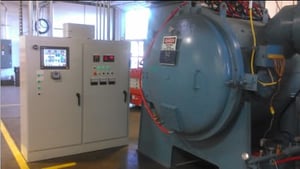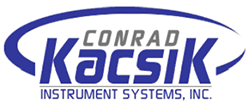
When it comes to pyrometry and thermal processing, details are critical. Adhering to the exacting AMS2750E standard demands that each step of heat treating meets specific requirements for sensors, instrumentation, equipment, tests and other details.
Any confusion in terminology can cause missteps that lead to audit findings, and this is particularly true when it comes to temperature uniformity surveys as applied to AMS2750E.
The AMS2750E standard specifies which thermocouple sensors are to be used. AMS2750E is a standard for heat treatment in the aerospace and automotive industries.
To ensure you’re correctly interpreting these AMS2750E heat treatment standards, I’ve explained some key definitions that could cause confusion and the differences between them.
Control Zone Versus Qualified Work Zone
A qualified work zone is a defined area in the furnace that meets a required uniformity tolerance while a control zone is part of the working zone that has a separate mechanism to control its temperature.
- Control Zone AMS2750E, page 44, para 2.2.9: “A portion of the work zone in thermal processing equipment having a separate sensor/instrument/heat input or output mechanism to control its temperature. This portion of a furnace is independently controlled.”
- Qualified Work Zone AMS2750E, page 6, para 2.2.42: “The defined portion of a furnace volume where temperature variation conforms to the required uniformity tolerance.”
Failure of a Survey Thermocouple
Failure of a thermocouple does not necessarily mean a failed result. AMS2750E allows for some temperature uniformity survey sensor failures, as long as they are not at the corners of the work zone (see AMS2750E, page 30, para 3.5.16).
According to AMS2750E, page 4, para 2.2.19: “Obviously incorrect or erratic activity of a survey thermocouple indicated by extreme high readings, extreme low readings, and/or erratic changes in readings not reflected by other sensors.”
Pyrometry technicians can see these failures in real time during the survey. Failures could be caused by:
- A loss in chrome due to vapor pressure in a vacuum furnace
- The thermocouple moving from the documented position during the test
- Polarity reversal during test thermocouple assembly
Heat Sink
AMS2750E, page 5, para 2.2.24: “A mass of material equivalent to the heat transfer characteristics of the thinnest section of the part being heat-treated. Heat sinks may be used during TUS (3.5.10.1) and during production (3.3.5).”
Using heat sinks during a temperature uniformity survey is optional. Operators can use heat sinks on test thermocouples and the load thermocouple. It’s important to document the initial TUS load condition, including the use of heat sinks, and use the same configuration on subsequent tests.
Heat sinks used on the TUS test thermocouples or the load thermocouples must comply with AMS2750E, page 26, para 3.5.10. Additional requirements and clarification regarding heat sink requirements are in the Nadcap Pyrometry Guide on page 47, question #43 and Heat Treat Auditor Advisory 17-007.
Qualified Operating Temperature Range
AMS2750E, page 6, para 2.2.41: “The temperature range of thermal processing equipment where temperature uniformity has been tested and found to be within required tolerances as specified in 3.3.”
The qualified operating temperature range affects multiple aspects of pyrometry, including the instrument calibration setpoints of both furnace instruments (AMS2750E page 14, para 3.2.5.5.1) and field test instruments used on that equipment (AMS2750E, page 14, para 3.2.5.4). It also affects what can be heat treated in the furnace.
Field Test Instrument
AMS2750E, page 4, para 2.2.20: “An instrument that is portable, that meets the requirements of Table 3, has calibration traceable to secondary equipment or better and is used to conduct on-site tests of thermal processing equipment.”
The term “portable” above is important because it implies that furnace instruments cannot be used as field test instruments. This may cause confusion because the same instrument make and model could be designated as a field test instrument or a furnace instrument. For example, the Yokogawa DX model electronic recorder could be used as a furnace recorder or a TUS recorder (making it a field test instrument). The differences are its designated use, calibration points and the fact that it is independent of the furnace (portable).
AMS2750E, page 14, para 3.2.5 calls for users to calibrate field test instruments using a standard instrument or better at six points with an accuracy of ±1°F or 0.1%, whichever is greater.
Temperature Uniformity
AMS2750E, page 7, para 2.2.66: “The temperature variation (usually expressed as ± degrees) within the qualified furnace work zone with respect to set point temperature. For retort furnaces where a sensor in the retort is used to control temperature, the temperature variation is with respect to the sensor in the retort and not to the furnace set temperature.”
The furnace class designation is critical when determining temperature uniformity because each furnace class and type has different requirements. It’s important to understand the temperature uniformity range and the process for which you need compliance when designating furnace class.
Temperature Uniformity Survey
AMS2750E, page 7, para 2.2.68: “A test or series of tests where calibrated field test instrumentation and sensors are used to measure temperature variation within the qualified furnace work zone prior to and after thermal stabilization.”
Pyrometry technicians understand that thermal inertia, or overshoot, spells doom for any process. Overshoot causes immediate failure and initiation of an internal root cause and corrective action (RCCA) per AMS2750E, page 34, para 4.2.
Clear Definitions Help Ensure Clear Audits
Understanding AMS2750E heat treatment standards is key to understanding AMS2750E requirements and meeting audit requirements.
If you have any AMS2750E questions, contact Conrad Kacsik.
To read more of Jason's articles related to Nadcap heat treat audits and pyrometry, you can visit his articles at HeatTreatToday.com as well as Thermal Processing Magazine.








